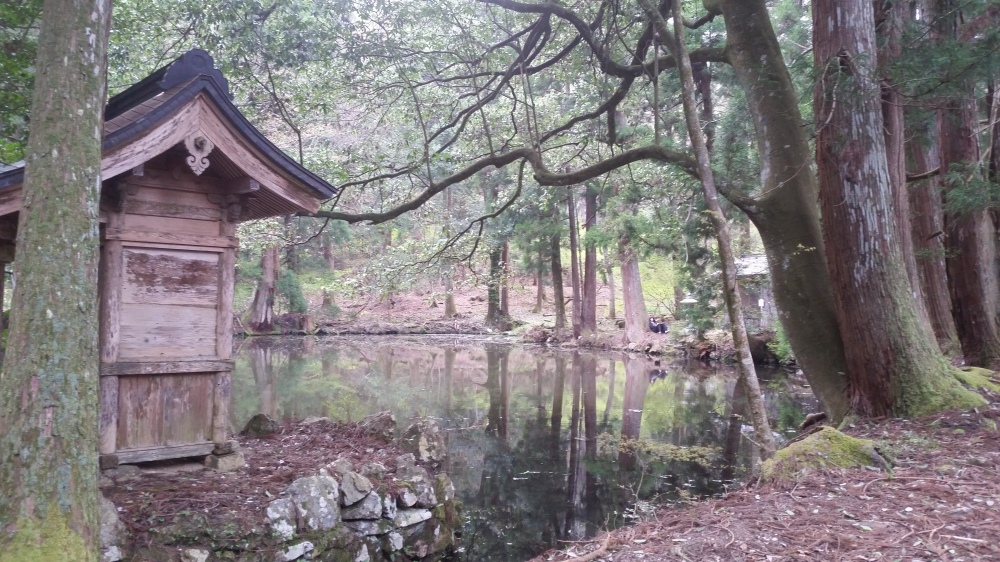Something about the trail drew me to it – ancient stone steps padded by fallen leaves finally thawed after the winter frost. Aware that the sun was beginning its descent, yet unable to contain my wanderlust, I took off down the stairs.
なにかで山道に引き込まれた ー ようやく冬の霜が解け、落葉で覆われた古い石段。日が傾き始めたと知っていたけど、放浪癖を押さえられなくて、階段を駆け下りていった。
Part I: Yogo 第一話:余呉
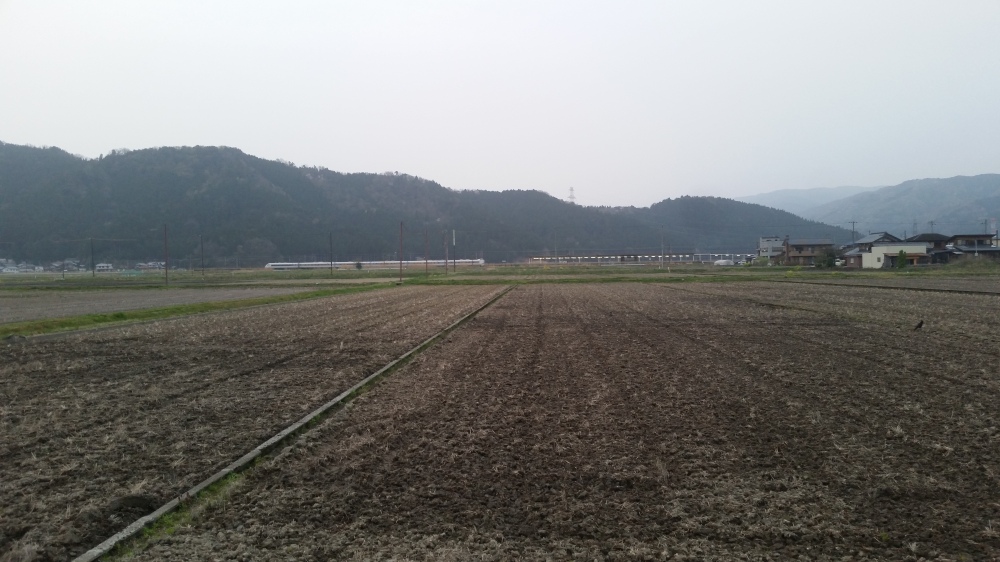
I had read a vague description a few months back about an abandoned Buddhist Temple with giant trees, somewhere in the mountains near Lake Yogo, but had no idea where it was really located. After a bit more information gathering and Google-mapping, I managed to round up a small crew of friends to check it out on a warm Sunday afternoon.
数か月間前、余呉湖の辺りの山に巨大な木がある廃墟となった寺のあいまいな話を聞いたけど、どこにあるかはっきり知らなかった。もうちょっと情報収集とグーグルマップ検索をしてから、暖かい日曜の昼に仲間と一緒に、お寺を調べに行ってみた。
We rode the Biwako Line up the east side of Lake Biwa, passing Nagahama and arriving to Yogo Station around 1pm. After exiting the small building, I briefly consulted the map outside, which confirmed that there was indeed some sort of hiking trail.
琵琶湖の東側を通る琵琶湖線に乗って、長浜駅を通り過ぎて13時ごろ余呉駅に到着した。小さい駅ビルを出てから、外にあった地図をざっと見て、ハイキングコースがあるのを確認した。
Here is a version of the map with some English added:
ここは英語付き地図:
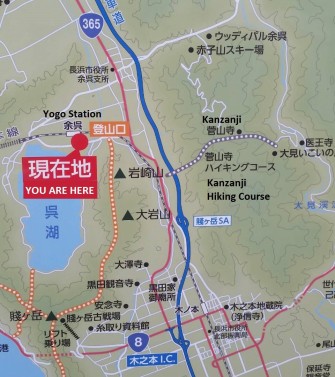
Google was a little less helpful this time around、but was a good reference point for finding the trailhead:
グーグルは今回あんまり役に立たなかったけど、登山口を見つけるにはいいきっかけになってくれた:
We took some liberties on the walk from the station, veering off of the recommended route in favor of more scenic and interesting areas.
駅からの道すがら、風光明媚で面白いエリアを楽しむために、ちょっと推奨ルートを外れてみた。
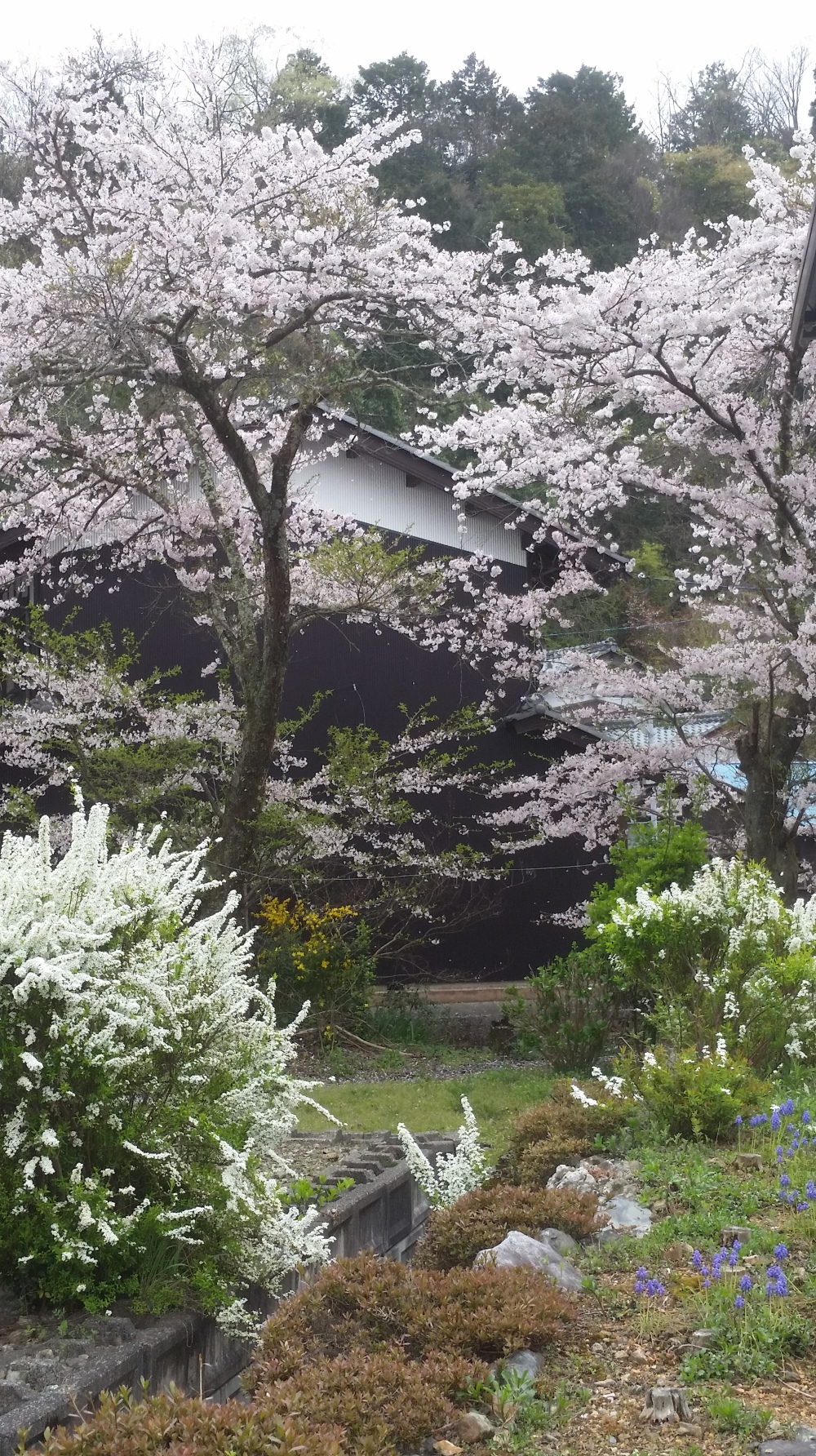
Just after turning left onto the “main” road, we stumbled across a little waterway, where we were caught in a flurry of sakura petals, falling like snow.
本道で左に曲がった直後、狭い水路を偶然に見つけた。そこで、桜吹雪に見舞われた。
We stayed for a few minutes, marveling at its fleeting beauty.
儚い美しさに思いをはせて、数分佇んでいた。「物の哀れ」と言えるね。
Just southeast from there awaited another classic Japanese scene, though we passed it by in our eagerness to see what lay in the mountains ahead.
そこからちょっと南東に、他の日本らしい景色が待っていたけど、先にある山の中にある物をみたいという思いの強さのせいで通り過ぎてしまった。
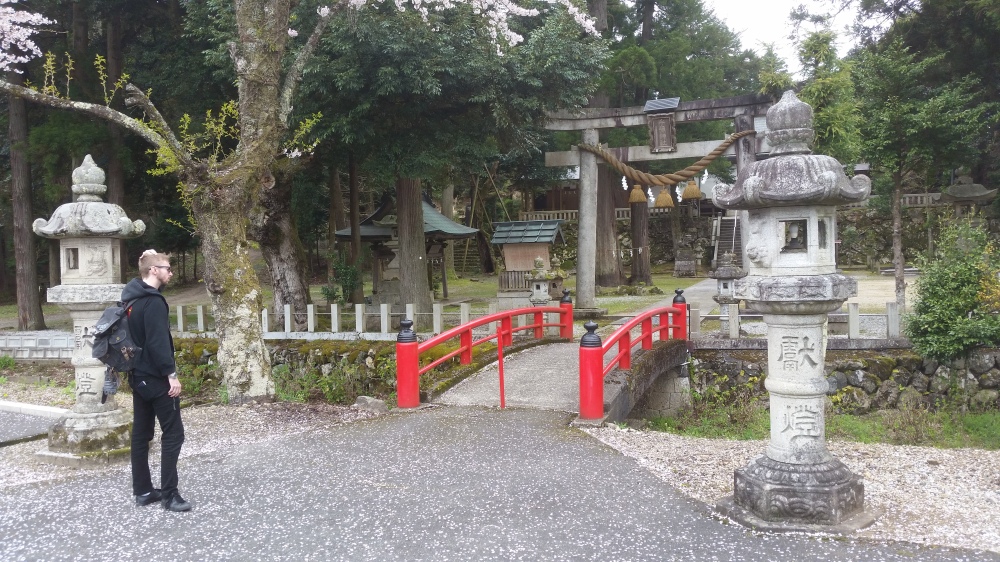
On a total whim, we detoured across a bridge and along a less-traveled path that traced the edge of the forest. Almost immediately, we were rewarded; first in the group, I caught a glimpse of something bright off to the right, and found myself staring into the eyes of a fairly large white rabbit. It sat frozen a few meters away, in front of a small shinto shrine. I inched closer, but it dashed off, legs flapping in a somewhat comical way, pausing only once to look back before disappearing up onto the trees beyond.
ふとした気まぐれで迂回路の橋を渡って、森の縁に沿ってあまり使われてない道を歩いて行った。すぐにその甲斐があった:グループの先頭にいた私は、右手に何か明るいものがちらっと見えたと思ったら、大きな白いウサギと目があった。数メートル先、小さい神社の前にじっと座っていた。私は少しずつ近づいたけど、面白い働きで足をばたつかせてウサギが走り出した。一回だけこちらを振り返り、向こうの木々の中に消えていった。
Our first nature sighting had us all excited, and we briefly considered taking a page from Alice and following it, but decided to appreciate it as a good omen and move on.
最初の自然との出会いにみなは盛り上がって、いったんアリスを真似してウサギを追うのを考えた。けれど、良い前兆としてありがたく思って先に進んだ。
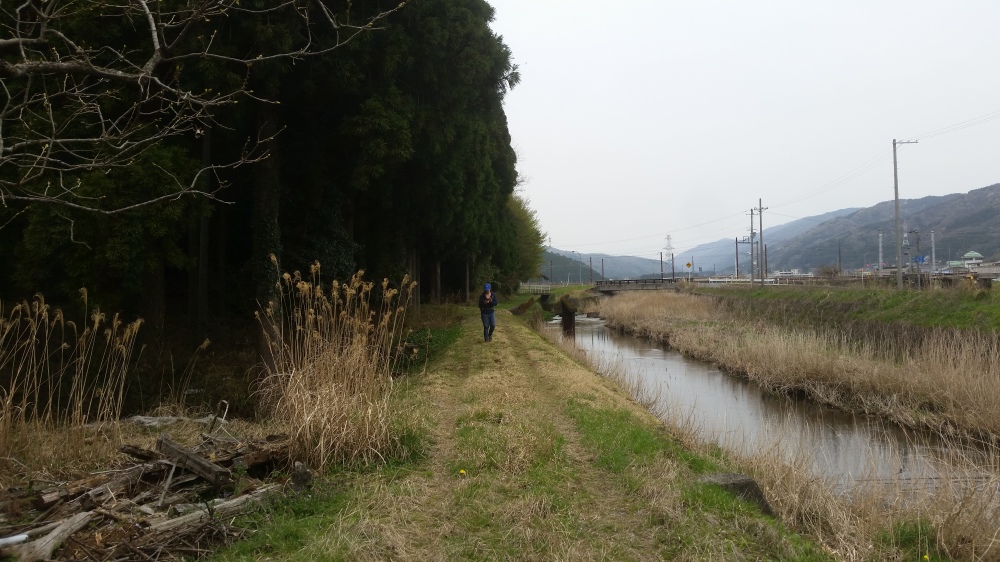
It had been less than a minute when I heard a shout behind me. I whirled around to find two of my friends checking out a snake that was coiled up in a defensive position, having just narrowly avoided being stepped on.
ウサギを見てから一分も経たずに背後で叫び声が聞こえた。くるっと振り向くと、仲間の二人が危うく踏みかけた、とぐろ巻いて防御態勢にある蛇を見ていた。
Luckily, we had our Kentuckian snake expert along for the day, who was about to try to pick it up when she noticed the telltale shape of its head. Instead of taking the risk, she managed to snap a couple photographs:
運よく、ケンタッキー出身の蛇に詳しい人が一緒にいて、彼女は捕まえかけたときに頭の形に気づいた。危険を冒す代わりに、彼女はなんとか写真を二枚取った。:
Turns out her snake id skills are on point – after consulting a couple of databases, we are pretty sure this guy was a Mamushi, or Japanese Pit Viper, one of the most venomous snakes in Japan!
彼女の蛇の知識は的を得ていたことがわかった - ネットで検索すると、こいつは確かに日本で一番やばい毒蛇の「マムシ」だったと思う!
The next nature find was this cluster of much less dangerous flowers, known as oomutsukokisou, or “Summer Snowflake” in English. (Leucojum aestivum, for you scientist types.) Apparently it’s actually native to Europe, but we saw a lot of them on the edges of farms in Yogo.
次の自然発見はこの危なくない花の房: オオムツコキソウ。(科学者タイプのため:Leucojum aestivum)。実はヨーロッパの花だけど、余呉の農場の縁でたくさん見た。
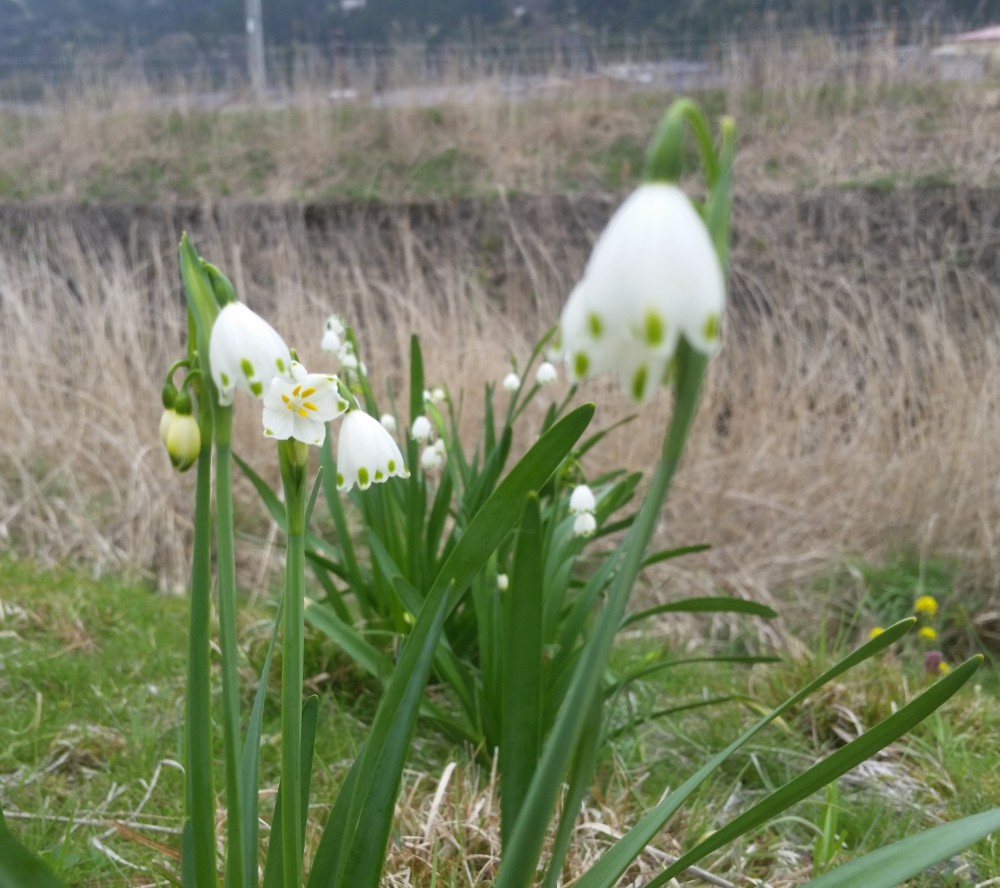
It took us a good hour or so to get to the trailhead, but that was due to a lot of meandering and trouble with directions. If you’re heading out on the hike using the pins I’ve included here, expect a 20-30 minute walk from Yogo Station to the true starting point, a vermillion torii gate, located here:
登山口までは1時間以上かかったけど、それは道に迷ったり、くねくね歩いたりしたことのせいだった。皆さんはここでシェアしたピンを使ったら、余呉駅から本当の登山口の朱塗り鳥居まで20~30分ぐらいかかると見込んでください。鳥居はここ:
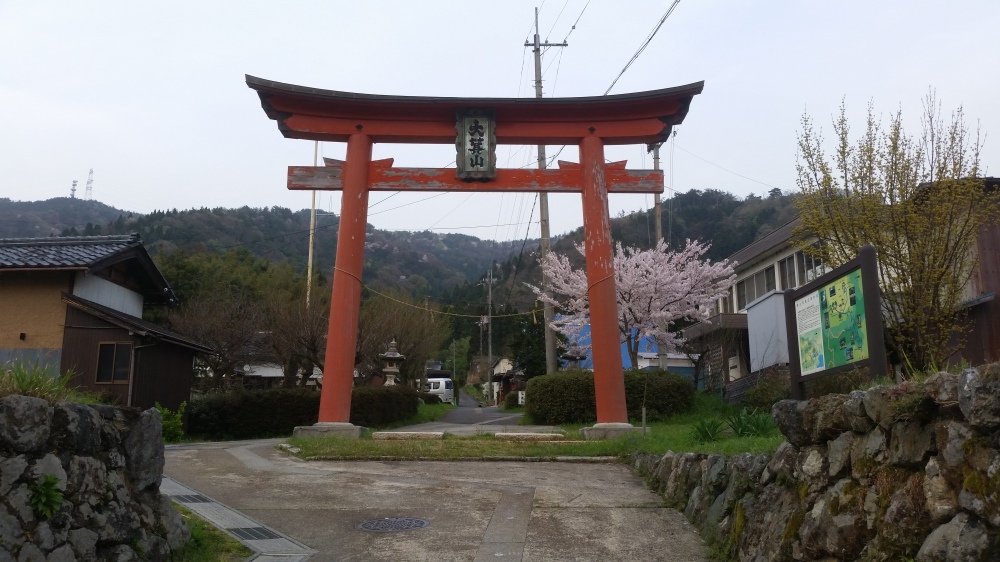
From the torii, go straight up towards the mountains. After a couple of minutes, you’ll pass through a tunnel under the Hokuriku Expressway (北陸自動車道), and see this sign and a trail leading off to the left:
鳥居から、山方向へ行ってください。数分後、北陸自動車道の下のトンネルを通って、そしてこの標識と左手に続く山道を見る。
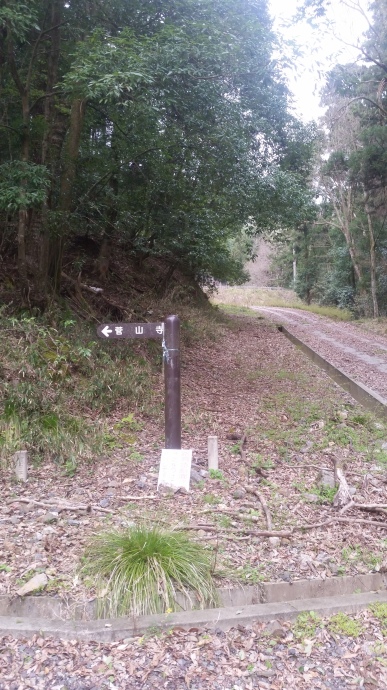
For reference, this is the kanji for Kanzanji: 管山寺 (There’s no English on any of the signs.)
参考として、これはお寺の漢字: 管山寺 (サインには英語・ふりがな・等がない)
After almost giving up when we couldn’t find the torii (we came from a totally different route by accident), this sign was a huge relief. Hopefully, if you’re following this guide, you’ll get to it with no trouble at all.
鳥居を見つけられずほとんどあきらめた後(私たちは誤って他のルートから来たから)、この標識を見てすごく安心。このガイドを見れば、問題なくて着くと思う。
Part II: The Hike 第2話: 登る時
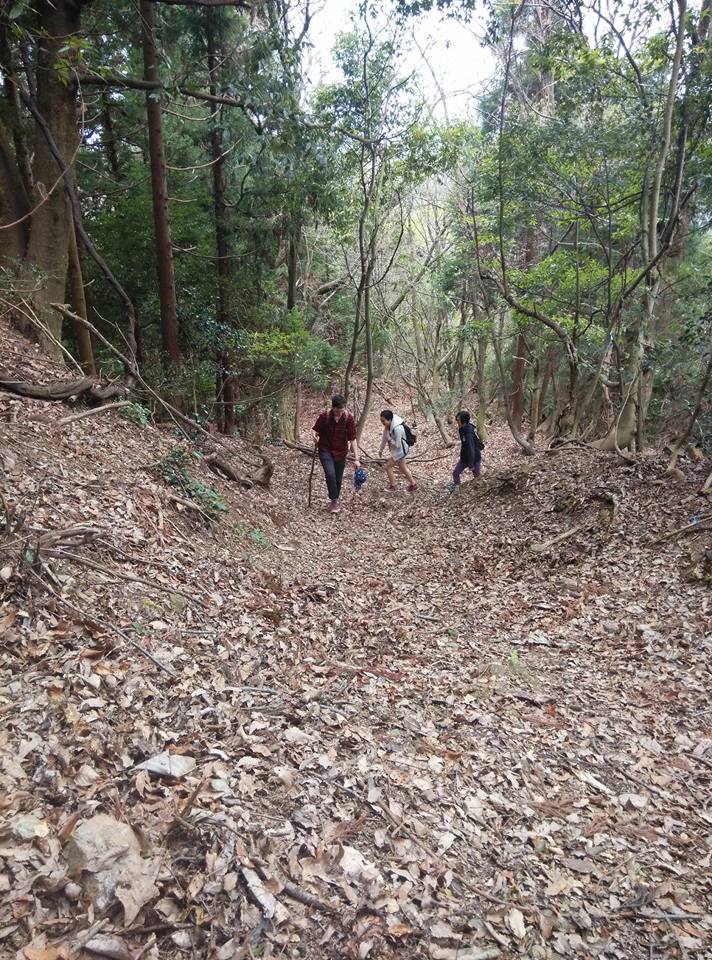
If you’re not used to hiking in Japan, there are a couple things to keep in mind:
1. The trails tend to be extremely steep (as is the nature of Japanese mountains).
2. The fallen leaves on the trail often cover loose rock and it’s easy to lose your footing if you have the wrong shoes. (Hiking boots recommended, though we did it just fine in sneakers)
3. If you have allergies, you might want to avoid doing this trail during spring.
4. Bring plenty of water and snacks, and buy them BEFORE you get to Yogo! We didn’t see any convenience stores and only passed by a limited number of vending machines.
日本でハイキングすることに慣れてない人には、ちょっと覚えてほしいことがある:
1.(日本の山ではいつものように)山道がたいへん険しい。
2.山道の落葉は浮石を隠すから、適切な靴がないと足を滑らしやすい。
3.花粉症がある人なら、春に登るのをたぶん避けた方がいい。
4.水・食べ物も十分持って。そして、余呉に着く前に買ってください!余呉でコンビニを見てないし、自動販売機も少ない。
***
Once you start up the trail, there should be pile of walking sticks used by other hikers. You’ll round a bend and immediately see this shrine.
上り始める時、他のハイカーが使った杖がたくさんある。その後、カーブして、さっそくこの神社を見る。
It’s hard to see in the photograph, but the red paint residue on the torii and fox sculptures indicate that this is a shrine to the god Inari.
写真であまり見えないけど、鳥居に朱塗りの残りがあって、キツネの像でこれは稲荷神社ということがわかる。
As you continue to climb, you will pass a total of 88 small sculptures, each one slightly different:
登り続けると、88個の小さい石像を通りすぎる。それぞれ少しづつ違う。
…and some in better shape than others…
…そして、もっと形の良いものもあれば…
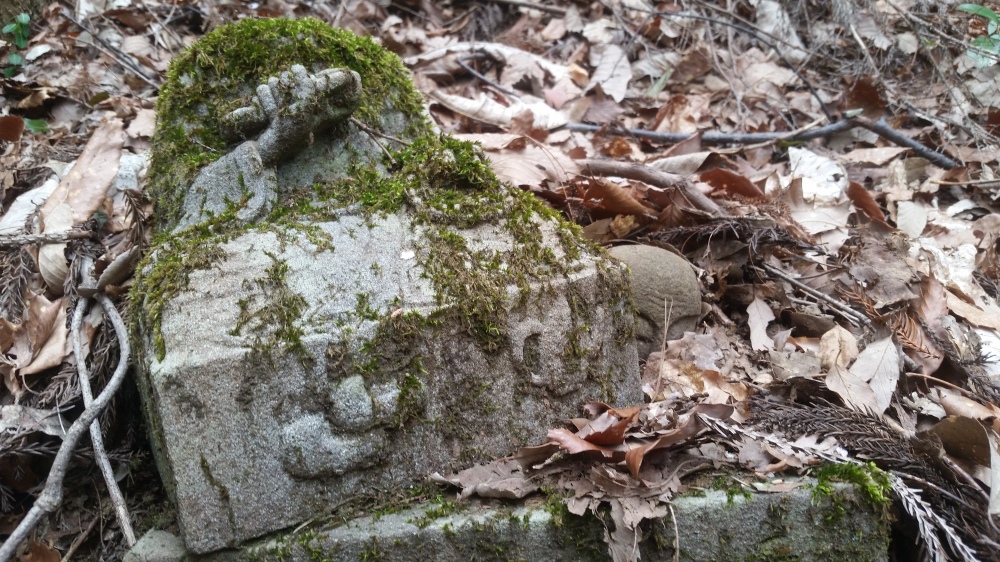
…but the decay of the place is part of what makes this mountain so mysterious and beautiful.
でも、この山の不思議で美しいところの一つは朽ちた感じのおかげだと思う。
There are also plenty of trees to check out, some with tags:
面白い木もいっぱいある。時々タッグがついている:
I haven’t identified the one on the left (if you know, please comment!), but the one on the right is an Akagashi, or Japanese Evergreen Oak (quercus acuta), as the sign says. According to James Goedkoop at AikiWeb, it is the wood of choice for making bokken (wooden training swords).
左の木の種類がわからない(知っている方はコメントしてくれると、ありがたい!)けど、サインで、右のはアカガシ。 AikiWebでジェームズ・ゴッコープによると、アカガシは木刀の素材として優れている。
After a good hour or two, you will reach the summit – but not the temple! You’ll know the spot because there is a big sign, a bench, and the trail splits three ways: left, right, and straight. If you look at the sign – which I unfortunately have no pictures of – you’ll see Kanzanji marked on the map, but it will look like you’ve only made it halfway. Fear not! It’s not to scale. It should only take 10-20 minutes from there.
1・2時間後、頂上に着く - でもお寺はまだ!頂上がわかるのは、大きい標識とベンチがあって、道は三つの方向(左・右・前)に続くことから。標識を調べたら(写真がなくてすみません)、地図で管山寺までのコースの半分しか歩いてないみたいけど、安心!一定の縮尺じゃない。頂上から10~20分しかかからないと思う。
If you have the time, follow the trail off to the left for a minute or two for a nice view of Lake Yogo and the surrounding mountains:
時間があればこのきれいな景色を見るために、左の道を1、2分間歩いて。
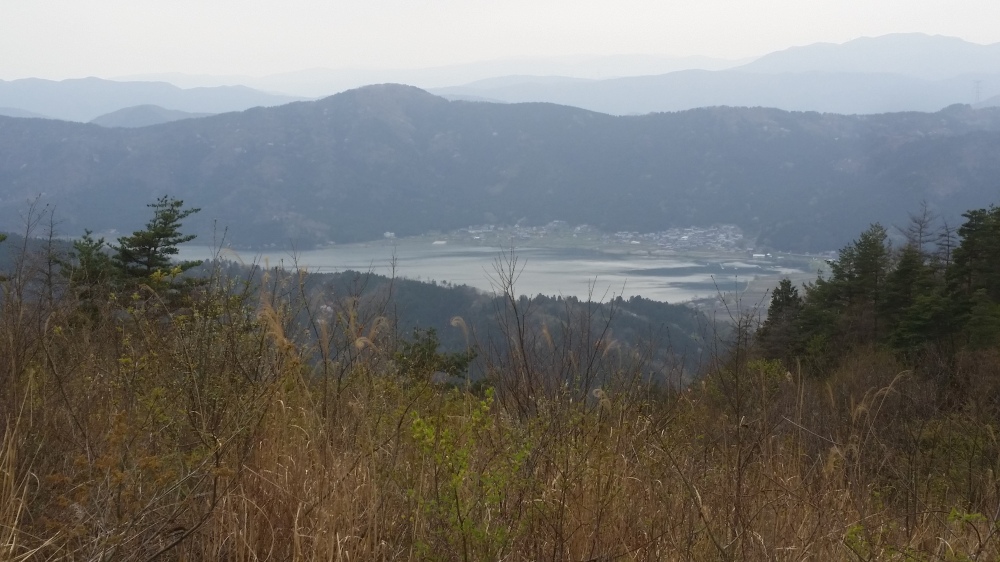
There is also some sort of power station and paved road here, so take note of it in case of an emergency.
ここで、発電所みたいなビルと舗装路があるから、非常時のために覚えておいてください。
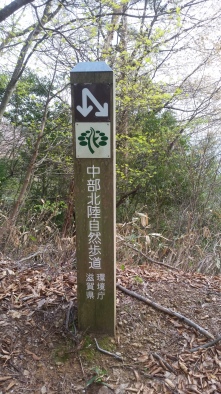
Another sign indicates that this is part of the Chubu-Hokuriku Nature Path, a series of trails that extends from Niigata to Shiga. Click here for more information. (Japanese only)
これは中部北陸自然歩道という新潟県から滋賀県まで伸びている山道の一つだと他の標識で示されている。詳しい情報はここ。(日本語だけ)
From the summit, head straight and the trail will dip down. It’s very steep and easy to lose your footing (one of the reasons to grab a walking stick when you first start out). After only a couple of minutes, you will catch a glimpse of the sloping green roof of the main hall of Kanzanji.
頂上から、まっすぐ進んで、ちょっと降りる。すごく険しくて滑りやすい(登山口から杖を持っていく理由)。数分後、管山寺の本堂の青い斜め屋根が見える。
Part III: The Temple 第2話: 登る時
I won’t spoil that first sighting, because it feels like something out of a dream.
夢に出てくるような景色だから、他の人が初めて目にする時の感想を台無しにしたくない。
There is plenty to explore there:
そこで探検するところがいっぱい:
A highlight, of course, is the pair of towering Zelkova trees on either side of the temple gate.
ハイライトは、もちろん、山門の右左にそびえているケヤキ。
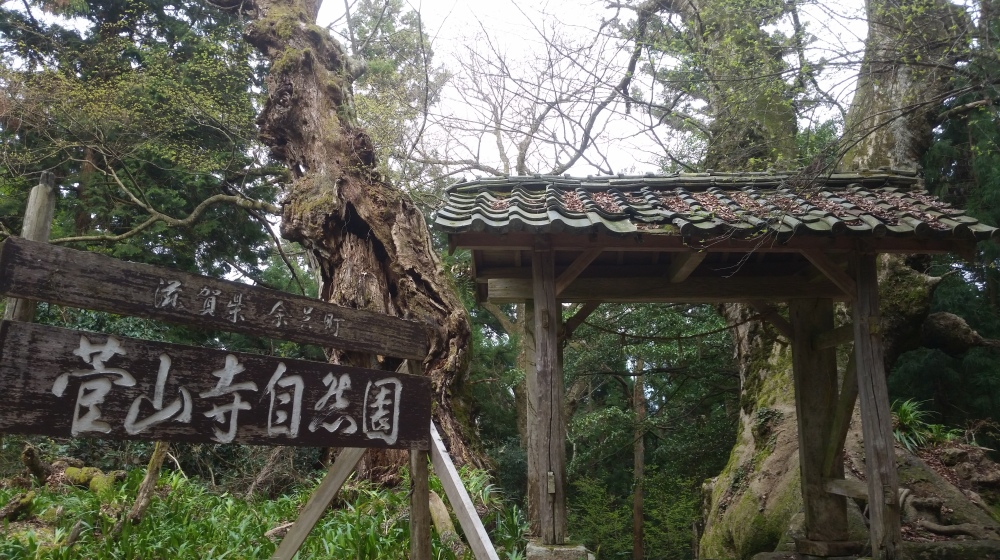
For a sense of scale:
大きさを感じるため:
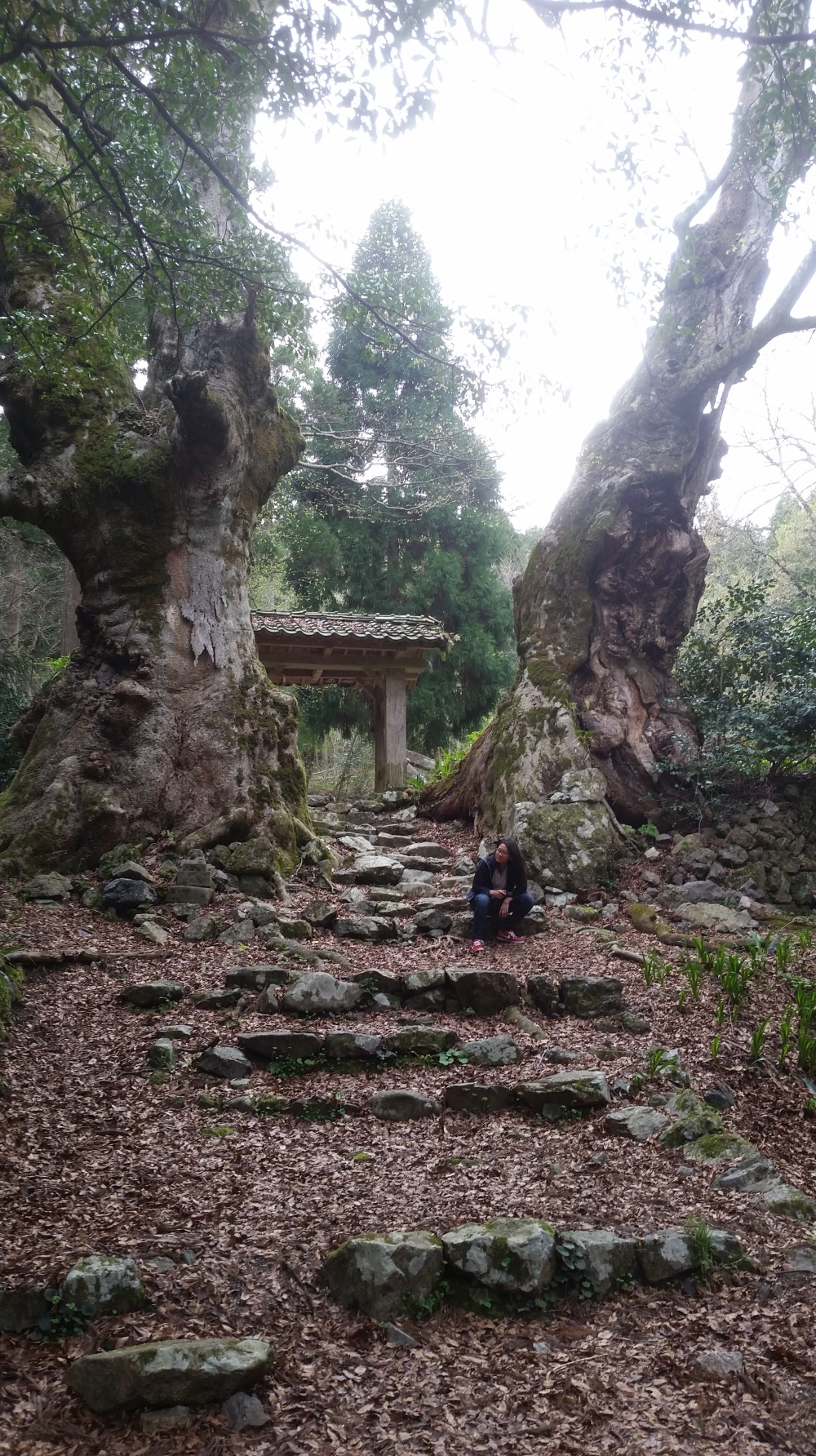
These trees are over 1000 years old. Legend has it they were hand-planted by Sugawara no Michizane, an important scholar of the Heian Period who is now revered as the god of learning in Shinto religion. (Tenmangu Shrines are dedicated to him).
このケヤキは1000歳以上。伝説によると、菅原道真(すがわらのみちざね)によって植えられた。菅原道真は平安時代の重要な学者で現在の神道で学術の神として祀られている。(天満宮は彼を祀っている)
Further down the trail from the gate lies the huge main hall. (There are also some red donation boxes where you can give a little money to help support the upkeep of the area)
山門から先は巨大な本堂がある。(区域の保守に寄付をするための赤い賽銭箱がある)
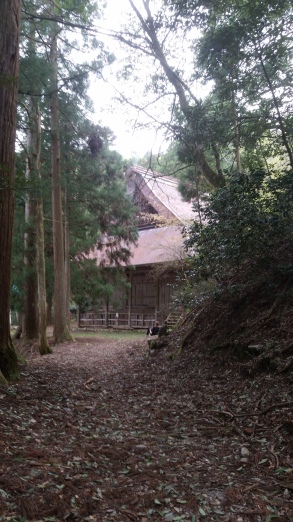
Next to the main hall used to hang a bronze bell, carrying an inscription from the mid-Kamakura Period. Unfortunately, it was gone when we arrived – hopefully not taken by thieves.
昔は本堂の側に鎌倉時代中期の作銘を持つ銅鐘があったそうだ。残念ながら、私たちが行った時にはなかった。盗まれたんじゃないといいね。
—
In front of the main hall was where I found the mysterious path that drew me away from the rest of my companions. It was a wide path with stone steps and a stone wall on the right, but there was nothing visible down it except for more forest. As I reached the first bend, I noticed something strange ahead: Trees seemed to stretch down further than before, and there was a change in the air quality. Water.
本堂の前に不思議な道を見つけてたどっていき、私は仲間からはぐれてしまった。けっこう広くて石段と石壁があった道だったけど、向こうは森林しか見えなかった。最初のカーブを曲がると、何か不思議なことに気づいた:森がさっきより深くなっていた。そして、空気に変化があった。水だ。
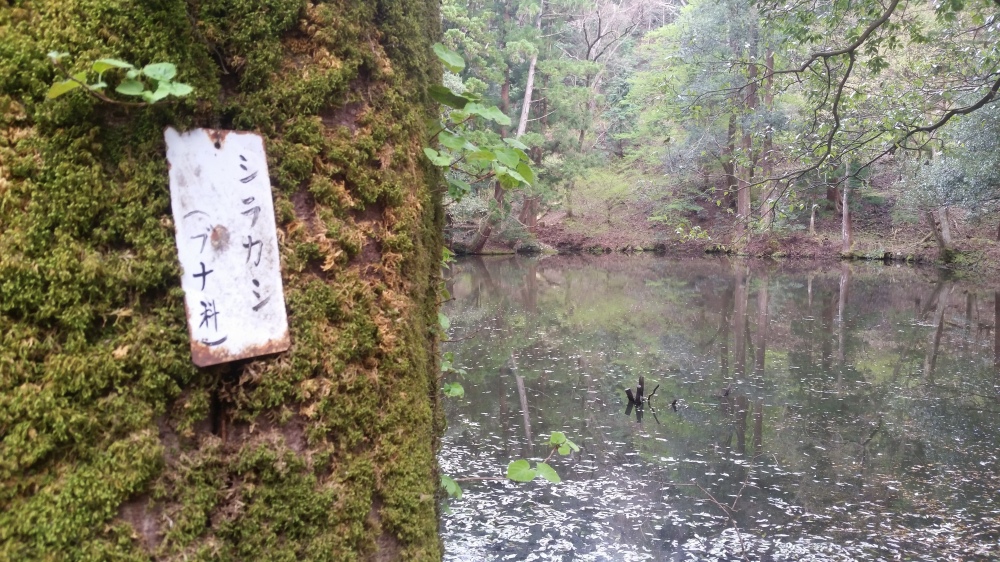
I found myself suddenly at the edge of a huge pond, opposite another building and a smaller shrine out on a little island. Working my way along the edge, I passed a very mossy White Oak. Nearby, I was amazed to find a koi fish still swimming in the lake.
突然、私は広い池の縁に立っていた。もうひとつの建物と狭い島にあった小さい神社が対岸にあった。縁に沿って歩きながら、苔におおわれた白樫のそばを通った。その辺の池の中に鯉がまだ泳いでいることにびっくりした。
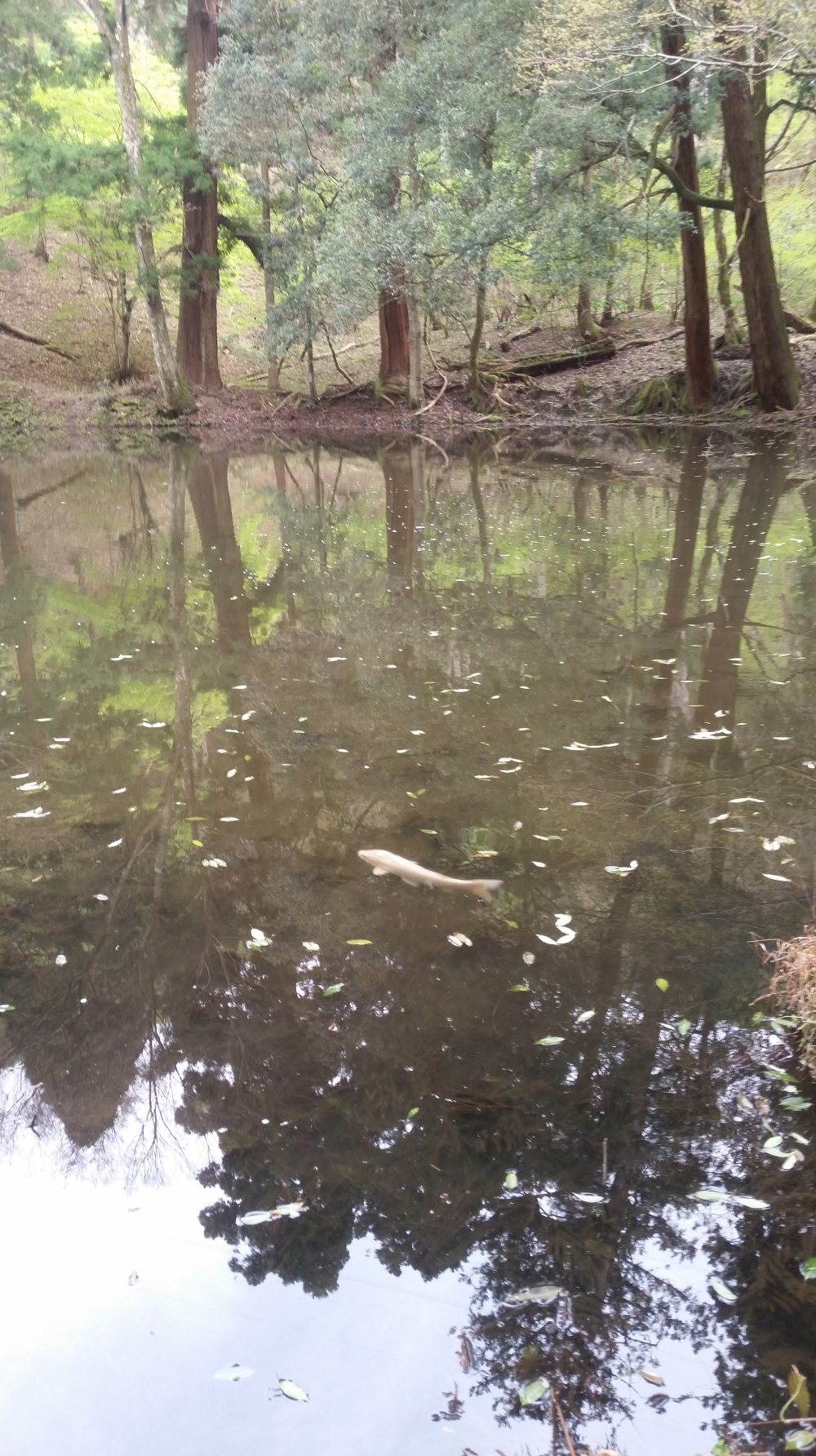
After an exchange of bird calls with the others, they eventually made their way down, expressing just as much awe at the scene as I had. It was one of the most surreal and magical experiences any of us have had during our time in Japan, and we were all reluctant to leave. However, the sun began to set, and we had a long journey home.
遠くにいた仲間と鳥の鳴き声の真似を交換しながら、みなもやっと池まで来て、私と同じぐらい感動した。私たちが日本で過ごした中で、最も非現実的で幻想的な経験だった。帰りたくなかった。しかし、太陽は落ち始めて、私たちは長い家路に就いた。
